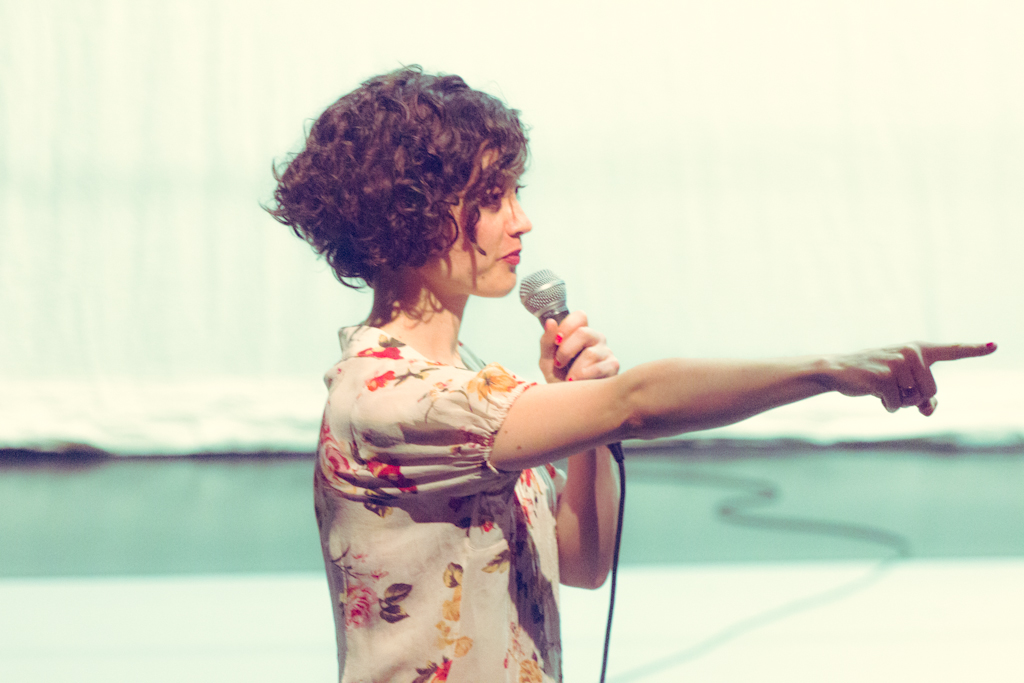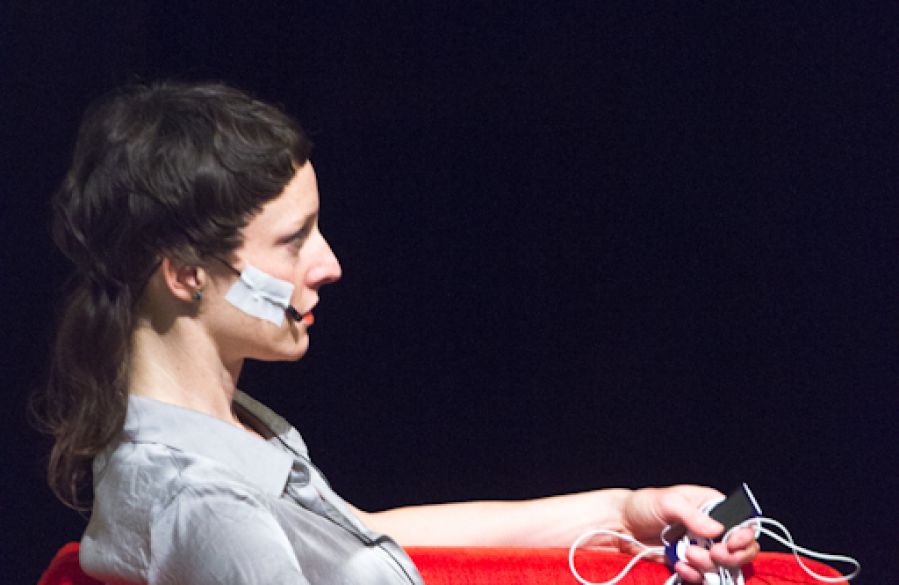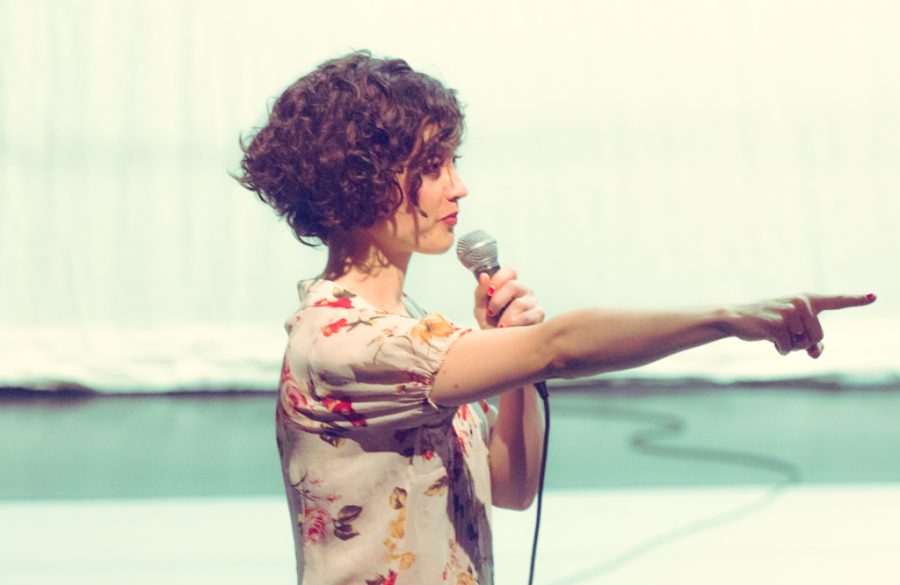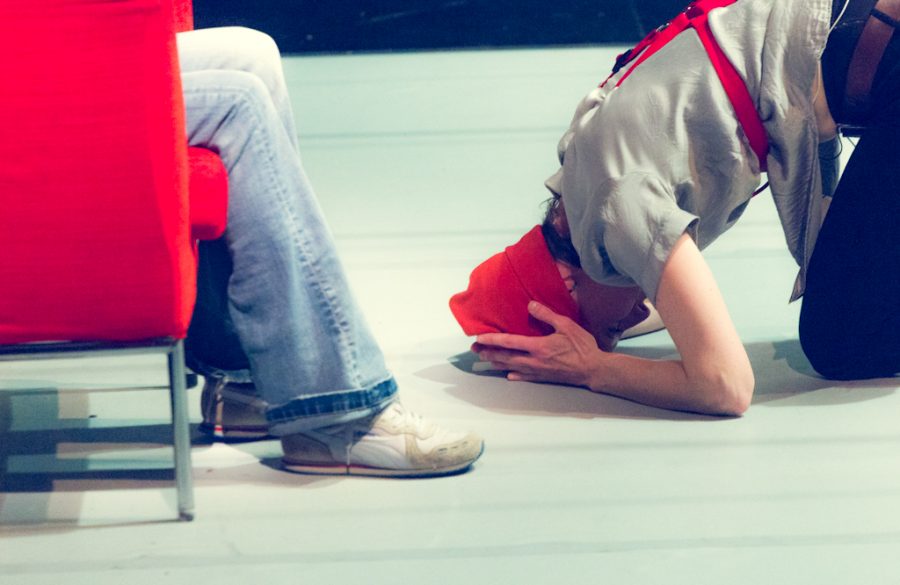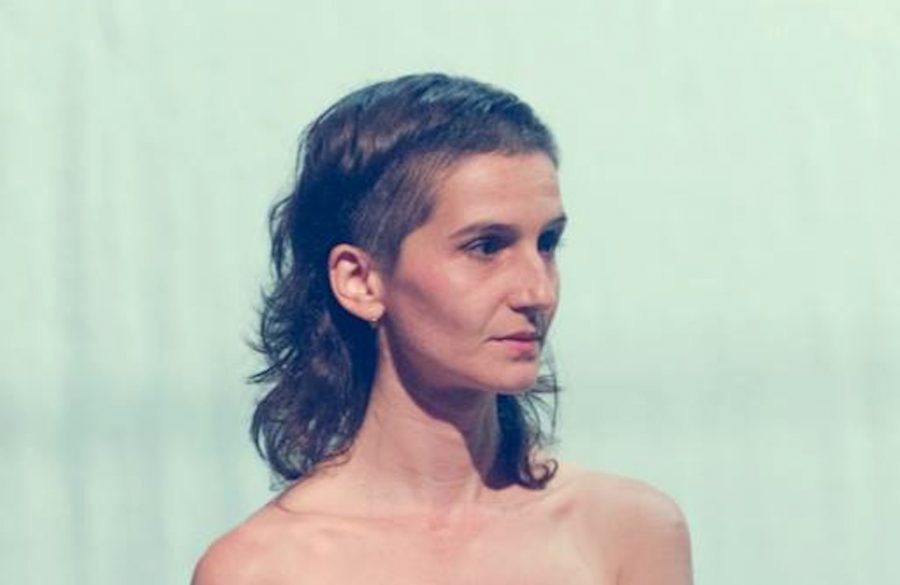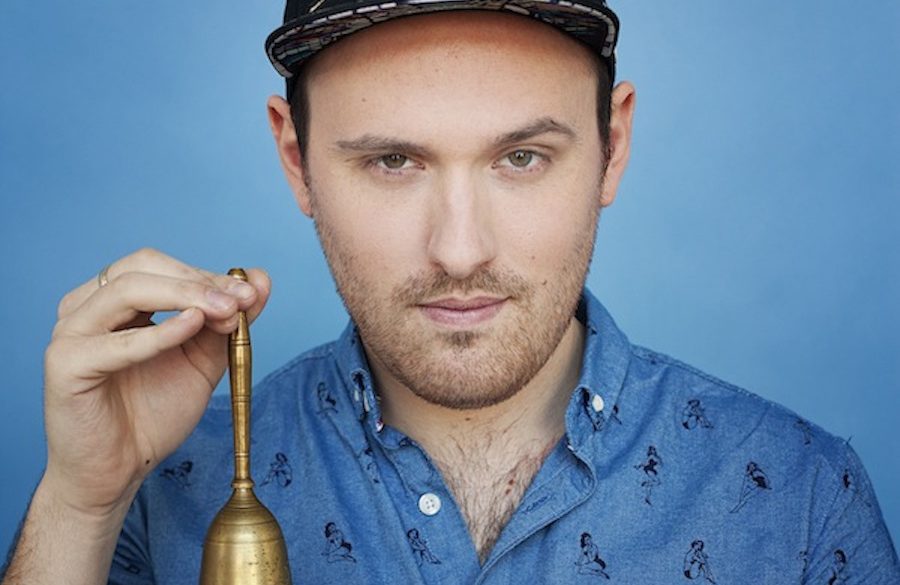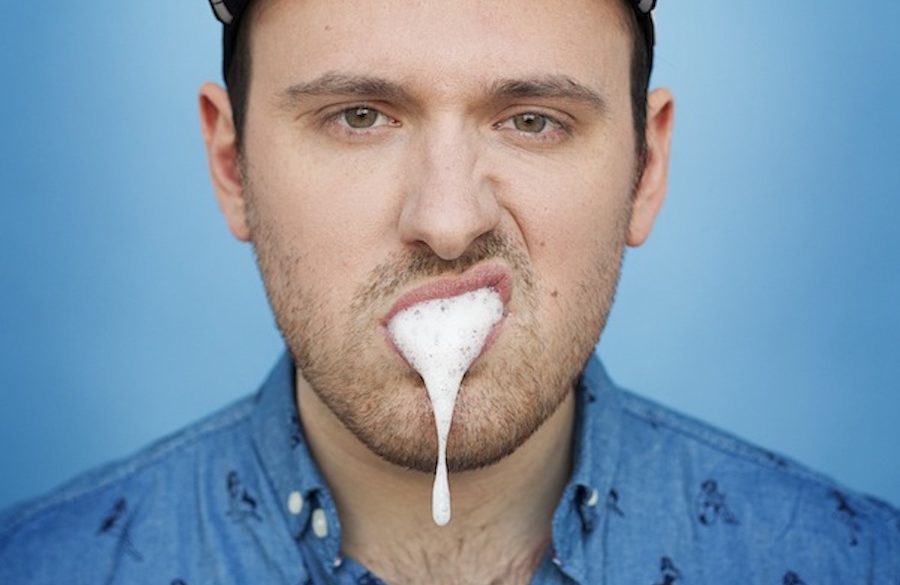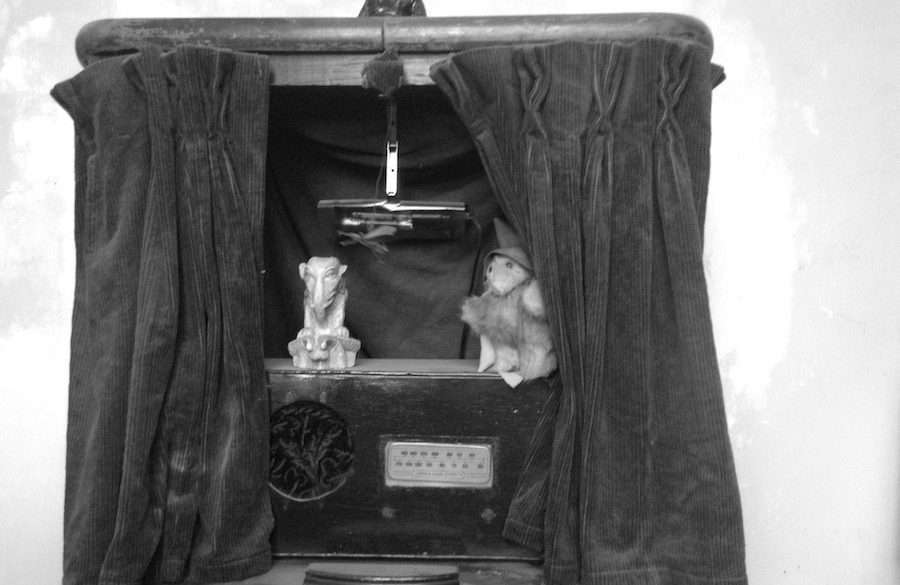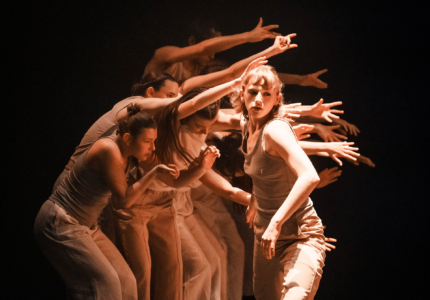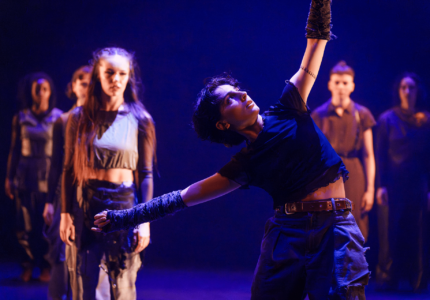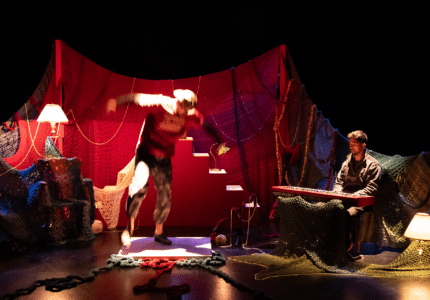Surprising audiences
Maria Kefirova
The Only Reason I Exist Is You, also: Why dogs are successful on stage?
A screen blocks our view of the stage, and to the left we see an empty chair. In a careful attempt not to reveal the delightful mysteries of this proposal, it may be cautiously be mentioned that the work is about the beauty of the human face, the ways we perform ourselves, and the investigation of sharing and togetherness within a theatre situation. The choreographer will be your mistress of ceremonies, and there are indeed ardent dancers performing for us. Enough said! If you have never before experienced this artist’s interdisciplinary excursions into live performance, this piece provides an ideal starting point. Here, discomfort and epiphany keep company. We promise that your consciousness of spectating will be changed if you choose, willingly, to participate. And so, why is it that dogs are so successful on stage?
Concept and choreography Maria Kefirova
Performers Sara Hanley, Karen Fennell, Kelly Keenan, Maria Kefirova
Lighting design Paul Chambers
« José Navas/Compagnie Flak is proud to sponsor this artist as part of their residency partnership with Tangente. »
Bulgarian born Maria Kefirova is a dancer and choreographer based since 1992 in Montreal. Parallel to her work as a performer, she has been developing her own artistic practice combining dance, theatre, performance and video. The main focus in her work is the correlation between internal and external realities, as well as the body’s role as an interface between the two, which is at the heart of many of her works (The Nutcracker – 2014, Corps. Relations – 2010, Gold Meat – 2010, Manufacturing Tears – 2009). Through choreography she wishes to build physical spaces for movement of attention, thought and energy (No Distance – 2016, The Paradise -2015 and Why are dogs successful on stage? – 2012). From 2009 to 2012, Maria was a participant at DasArts, a residential laboratory for performing arts, research and innovation located in Amsterdam. Maria regularly teaches workshops and expands her own choreographic practice through collaborations with other artist (Miguel Melgarez, Jean -Francois Laporte, Hanako Hoshimi- Caines, Lina Cruz, Lynda Gaudreau and Sameena Sitbakhan).
Karen Fennell is a contemporary dance artist originally from Newfoundland, and now based in Montreal. A graduate of the Concordia University Dance Program, she has worked as a dancer with choreographers Dana Gingras, Sasha Kleinplatz, Susanna Hood, Maria Kefirova, Erin Flynn, and Peter Trosztmer, among others. She has also performed in the installation / performance work of visual artists Chloe Lum and Yannick Desranleau. As a choreographer, her own short works have been presented on a variety of stages in Montreal, Quebec City, and Halifax. From 2013-2015 she collaborated regularly with musician Jackie Gallant, and their interdisciplinary co-creations were presented by the Phenomena Festival, Edgy Redux, The Rhubarb Festival, and Tangente. She is currently working on a new collaborative creation with video artist Nikki Forrest. In addition to her work as a choreographer and dancer, Karen produces and hosts the open performance night, ‘So You Think That Was Dance?’ and is a certified instructor of the GYROTONIC® and GYROKINESIS® Methods.
Sara Hanley is a Montreal based artist. She navigates between the performing and visual arts and occupies alternately the roles of performer, choreographer, teacher, rehearsal director and cultural mediator. Sara begins a long collaboration with choreographer Dominique Porte/Système D as she finished her studies at EDCM. She also dances with Deborah Dunn / Trial and Eros, La Fondation Jean-Pierre Perreault, Sarah Bild, Maria Kefirova. Her training in the visual arts led Sara to focus more specifically on the interrelationship between art and community. The desire to democratize the act of creation and the performing space is central in her approach. She is currently working on the creation of an in situ performative project with Kelly Keenan
Kelly Keenan is a Montreal based dance artist and teacher. Kelly has collaborated in dance-making projects with Kira Kirsch, Adam Kinner, Maria Kefirova, Catherine Lavoie-Marcus, Sara Hanley and most recently Katie Ward. Kelly teaches contemporary technique at Concordia University’s Dance Department and frequently leads professional level workshops in Montreal, further abroad in Canada and internationally. Kelly has been reputed for her involvement with the Axis Syllabus International Research community as a teacher from 2006-2015 and as co-director of the North American Nomadic College 2012-2015. She is also the organizer of Montreal Movement Educator’s Forum.
Paul Chambers is a Montréal based set & lighting designer. Collaborating on new dance works has always been a priority for him. Teaching workshops has also been an important part of his development as an artist and mentor. At Studio 303 he teaches a yearly lighting design workshop for artists, in addition to teaching aspects of production in dance at Concordia University. From 2008 until 2013 Paul is Technical Director at Tangente: Laboratoire de Mouvement Contemporains. In 2013 along with fellow designer & educator David-Alexandre Chabot, they inaugurate CHA a design collective aimed at creating & sharring design based works with artists from different disciplines. Recent design credits include work with Public Recordings, 10 Gates Dancing, Audrey Bergeron, Dorian Nuskind-Oder, Benjamin Kamino, Dany Desjardins, Katie Ward, Susanna Hood, Sasha Kleinplatz, Antonija Livingstone, Adam Kinner, Maria Kefirova, Thierry Huard, Parts + Labour Dance, Lara Kramer Dance, & Destins Croisés.
During my stay in Europe between 2009 and 2012, I witnessed several contemporary dance and theater performances where dogs were taking central part in the artistic proposition. I was deeply captivated by the presence of these animals on stage.
My piece originates in the question: Why are dogs successful on stage?
The answers that I give to this question are the core of my creative process.
Dogs are successful on stage because:
– they are what they appear to be.
– they don’t talk and don’t take part in the agreement of conditions.
– they are unaware of their role.
-they move as fast as they think.
– they are displaced.
– they stay innocent and loyal in an artificial reality which is imposed on them.
– they don’t understand.
– it is a mystery how they perceive us.
Contemplating this question and the possible answers, brought me to think about the fundaments of dance performance, about what can be shared when we try to share what is not sharable, about the notions of visible and invisible reality, about personal and collective space, about fake and real presence.
Natacha Filiatrault
Pavlov morceaux
It’s high time to disrupt this time-honoured contract between spectator and performer, to question audience conditioning! Conceived by a choreographer and performed by an actor, this hilarious (and enervating) depiction of the classic television “crowd warmer” will certainly challenge your perceptions of both this heroic figure and our own tolerance for docility. In the style of an outlandish stand-up, the comedian does his utmost best to prepare us for a contemporary dance presentation for which he has only a rudimentary understanding. He’s a control freak! He compels us to applaud, louder and louder still, and rise up for serial standing ovations for a (fictive) performance. What will you do?
Choreographer Natacha Filiatrault
Performer and co-writer David Strasbourg
Lighting design Leticia Hamaoui
This show has benefited from the support of the Caisse Desjardins de la Culture with our crowdfundraising campaign « Give a hand to move a mountain! » on KissKissBankBank.
Natacha Filiatrault is a dance performer who is redirecting her carrier in choreagraphy. Working with people like Normand Marcy, Virginie Brunelle and Dave St-Pierre helped her perfecting her vision of creation while working creatively as a dancer and collaborator. She also sharpens her critical vision working as an “outside eye” and coach for Geneviève Gagné (pièce Action/Inversion). For Natacha, the ephemeral side of acting and of the stage in general is fascinating because the interpratation of the performers can change all in all from one day to another. It is important for this artist to work on pieces that include many artistic disciplines and that is why a creation based on the medium’s interbreeding is so appropriate for her. In 2012, she participated to the creation of Espace Temps, a piece presented at the SAT, in collaboration with Evelyne Drouin (Dj Mini). It is also during the creative process of the piece that she was able to get the support and mentorship of Margie Gillis. A big part of her present creative thought has come with her association with David Strasbourg, a well rounded artist and creator, who Natacha shares a similar vision with. After she proved that her voice was valid and necessary with PAVLOV, presented at Zone Homa in the summer of 2015, she intends to continue shaking the public’s comfort with her futur pieces.
David Strasbourg is graduated from the École de Théâtre de Saint-Hyacinthe class of 2012. Since then, we saw him in Warwick from Jean-Philippe Baril Guérard and also Ménagerie and Tranche-Cul from the same writer. He also worked with le théâtre de l’Opsis for the productions La Resistenza and Le Vertige. Il collaborated two times with Le Théâtre De La Bouilloire for Crustacés and Les Ordinateurs. Last summer, in Zone Homa’s festival, we saw him in Marie et Mario from Benjamin Prescott Larue. Since 2013, he participates to Jour 1’s a production from Le Petit Théâtre De Sherbrooke written by Érika Tremblay-Toy et Laurier Rajotte. He is also a member of L’Escadron Création, whom he has assured the assistance to staging La Sonate de Louis Slotin for, a theatrical production from Didier Lucien. Lately, he himself staged a piece called G-Money written by Guillaume Choquette.
It is only after I realized the importance of the unspoken but really established contract between the public and the performers that the idea of working on the subject of classical conditioning came to my mind. I was already working on a piece about the relation between internal and external stimulus and the performance itself, but my idea was not enough to build around. I knew I wanted to show how the public’s receptivity and the pre-acquired habits affect the development of a piece. The skeleton and the structure of the pieces I saw throughout the years was beginning to appear to me as more important than the content itself. I got the idea of comparing the public’s habits and reactions during a dance piece or a play to Pavlov’s classical conditioning theory. Why do we have the reflex of talking until the lights go off? What makes it ok to continue to talk even though performers are already in action during the public’s entrance? Why do we only reserve the ovations for the end. And what are the elements that could come and change that up? It is more towards the end of the creative process that the crowd warmer’s character appeared. I have to admit the working at a place like L’Astral, a venue for music and TV shows, helped me realize that crowd warmers are the perfect examples of classical conditioning instigators. That character, representing what would be Pavlov’s bell, then became the center of my piece.
Gaétan Leboeuf
Radio Danses
How might it possible to create a large star-studded cast, immensely exciting and monumental dance performance –the most ambitious choreography in the world in fact! -on a tiny stage and without funding? The composer has written his Radio Danses projects in response to this imperative. Each 6-minute “dance capsule” spins the tale of a virtual choreography that is heard, but never seen, by way of music, sound effects and the theatrical sports caster-like narration of actress Danièle Panneton. To begin: an old-time radio materializes in front of us on the bare stage. There are no dancers, no décor. We close our eyes as a dynamic voice fires our imagination in the dim half-light. The radio dance gradually takes shape and gains momentum, but only in our vivid mind’s eye.
Concept and sound design Gaétan Leboeuf
Voice Danièle Panneton
Composer, writer and singer, Gaétan Leboeuf composed music for dance, theatre, video production and music ensemble. He collaborated (among others) with Marie-Josée Chartier, Danièle Desnoyers, Paul-André Fortier, Margie Gillis, Ginette Laurin, Jean-Pierre Perreault, Harold Rhéaulme, Irène Stamou, Tom Stroud and Dough Varone in dance; Patrice Dubois, Martin Faucher, Gervais Gaudreault, Denis Marleau et Claude Poissant for theatre and with Marie Cadieux, Françoise Dugré, Bernar Hébert Jean-Pierre Masse, on video productions. He wrote three novels : two with Québec-Amérique and a third one, with Triptyques. He wrote a musical tale : Le réparateur de Noëls, created by the Ensemble Chorum at le Conservatoire de Musique de Montréal in 2011. Since 2008 he is a part time teacher at Concordia University Contemporary dance department.
Since she graduated in 1975 from the École nationale de théâtre du Canada in interpretation, Danièle Panneton has had the opportunity to play with various famous theater directors like Denis Marleau, the director of the Théâtre Ubu, with whom she has worked for more than 14 years both in Québec and in Europe, Lorraine Pintal, Claude Poissant, Jean-Pierre Ronfard, Wajdi Mouawad, Paul Buissonneau, Normand Chouinard and Brigitte Haentjens. She has directed herself a dozen of shows. For the cinema she was part, among others, of the casting of L’autre maison by Mathieu Roy (2013) and Pays by Chloé Robichaud (2016). This is for the TV that Danièle Panneton is known to the public. First, player for the Ligue nationale d’improvisation (LNI), she played then for TV-series appreciated by the public like Watatatow, Quatre et demi, Au nom de la loi, Providence, Toute la vérité and Nouvelle adresse. For more than 30 years, she has given her voice to numerous radio and TV adverts (Pantène 1994-2014), and doubled films, TV series, documentaries, and audio books. She has taught the class Voice and Micro at the Conservatoire d’art dramatique de Montréal. Finally, she has been part of the board of directors of the Théâtre Espace Go from 1996 to 2015 as a honorary member.
First, there is the desire to choreograph; the profound friendship with gestures and movements. And the overwhelming calling of tale, allegory, words and music, music that has swathed my life in so many rich and complex layers. There is this irrepressible drive to bond those languages in a graceful alliance. And finally, there is the beaming temptation of presumptuous excesses.
From those impulses come the first written notes, the first glimpses of ideas; some poor, others fruitful. Each can be seen as a particle. By their simple accumulation and through an accretion process, they become some sort of lump of matter from which diverse possibilities of meaning will emerge.
Hereafter starts a labour of deduction, of inquisition to comprehend the meaning that wants to get out and to grasp the aesthetical abstraction coming with it. And then we sculpt we sand, we sort and throw away to precise and enrich meaning and aesthetics, often intertwined. Since there are three art forms, and the interpretation, there will be back and forth “conversations”. The music will adapt itself to the text, the text to the imaginary gestures, the music to the evoked movement in space, the text to the music and the music to the interpreter of the text.
And then we stop because we have the feeling of completion. Or because it is time to go somewhere else.

